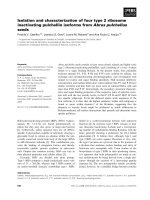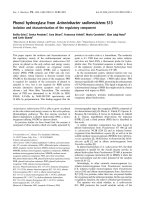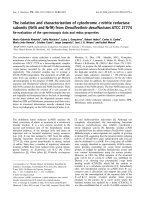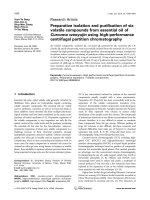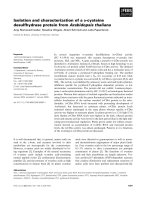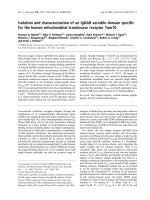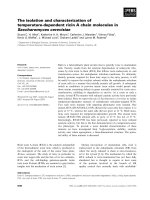isolation and selection of thermal tolerant toluene degrading bacteria
Bạn đang xem bản rút gọn của tài liệu. Xem và tải ngay bản đầy đủ của tài liệu tại đây (460.87 KB, 25 trang )
MINISTRY OF EDUCATION & TRAINING
CAN THO UNIVERSITY
BIOTECHNOLOGY RESEARCH & DEVELOPMENT INSTITUTE
SUMMARY
BACHELOR OF SCIENCE THESIS IN
BIOTECHNOLOGY
ISOLATION AND SELECTION OF THERMAL TOLERANT TOLUENE DEGRADING
BACTERIA
SUPERVISOR
Dr. NGUYEN HUU HIEP
STUDENT
VO NGOC THAO NGUYEN
Student code: 3082615
Session: 34 (2008-2013)
Can Tho, 2013
APPROVAL
SUPPERVISOR
Dr.NGUYEN HUU HIEP
STUDENT
VO NGOC THAO NGUYEN
Can Tho, May
, 2013
PRESIDENT OF EXAMINATION COMMITTEE
Abstract
Nowadays, the development of industry offers people a
better life. However, industrialization without caring about the
environment may lead to negative effects on the Earth as well as
human health. Therefore, the contamination of Toluene, an
organic solvent which is a common ingredient in painting and
leathering industry, has caught many attentions of scientists. The
aim of this research is to isolate and select thermal-tolerant
bacterial strains which are able to degrade Toluene. Soil samples
from four Toluene-contaminated sites in Can Tho city were
incubated with Toluene in both gas and liquid phase to increase
bacterial mass. MSB (mineral salt basal) medium was used for
the isolation of these bacteria. Isolated bacteria which were able
to use Toluene as a sole carbon source and synthesize enzyme
amylase, cellulase, lipase and protease were selected to identify
at molecular level. Moreover, drop count method was used to
examine the ability of degrade Toluene of bacteria. From four
soil sources, 09 bacterial strains were isolated. Most isolated
bacteria could produce enzyme amylase, cellulase, lipase and
protease. T14, T38 and T50 strains were selected for 16S rRNA
analysis and on the basis of 16S rRNA, they were assigned to
Bacillus licheniformis, Bacillus subtilis, Acinetobacter sp,
respectively. T38 (Bacillus subtilis) could use Toluene as a sole
carbon source at 1% and 1.5%.
Key words: Bacteria, degradation, isolation, organic solvents,
Toluene contamination.
i
CONTENTS
ABSTRACT……………………………………………….........i
CONTENTS..………………………..……………...…….........ii
1. INTRODUCTION ..................................................................... 1
2. MATERIALS AND METHODS .............................................. 2
2.1. Materials............................................................................. 2
2.2. Methods .............................................................................. 2
2.2.1. Isolation of bacteria ..................................................... 2
2.2.2 Study of the ability to degrade Toluene ....................... 2
2.2.3. Study of the ability to produce some enzymes ............ 3
3. RESULTS AND DISCUSSIONS ............................................. 4
3.1. Result of isolation of thermal-tolerant Toluene degrading
bacteria............................................................................... 4
3.2. Result of study of the ability to degrade Toluene .............. 5
3.3. Result of the ability to produce enzymes of isolated strains
........................................................................................... 7
3.4. Result of identification of selected bacterial strains at
molecular level................................................................. 12
3.5. Result of experiment proving ability to degrade Toluene of
selected bacterial strains .................................................. 17
4. CONCLUSIONS AND SUGGESTIONS ............................... 19
4.1. Conclusions ...................................................................... 19
4.2. Suggestions ...................................................................... 19
REFERENCES ............................................................................ 20
ii
1. INTRODUCTION
The development of industry offers human being a better
life. However, it cannot be denied that industrializing without
caring about protecting the environment may bring serious
environmental hazards. Especially, toxic chemical like Toluene,
an organic solvent discarded from manufacture processes, could
directly affect to human health as well as ecosystem (Lau, 2011).
Among many traditional methods used to treat organic
contamination, bioremediation appears as an outstanding method
because it does not cost much and eco-friendly. Therefore,
scientists around the world have been interested in figuring out
bacteria that have ability to degrade organic solvents. Vietnam
with an abundant bacterial population will be a promising site for
isolating potential Toluene degrading bacterial strains.
Objectives
To isolate and select thermal-tolerant Toluene-degrading
bacteria.
1
2. MATERIALS AND METHODS
2.1. Materials
Soil sample from four potential sites in exposuring to
Toluene in Can Tho city
Medium: MSB (mineral salt basal) medium (Na et al.,
2005) : K2HPO4 : 4.5 g/l, KH2PO4 : 3.4 g/l, (NH4)2SO4 : 2 g/l,
MgCl2.6H2O : 0.34 g/l, MnCl2.4H2O : 0.1 g, FeSO4 : 0.6 g,
CaCl2.2H2O : 2.6 g, Na2MoO4 : 0.02 g, ZnCl2.7H2O : 0.01 g,
CoCl2.6H2O : 0.01 g, CuSO4 : 0.01 g, NiSO4.6H2O : 0.001 g,
NaSeO4 : 0,001 g per liter of deionized water
Chemicals and equipments in Microbiology laboratory
2.2. Methods
2.2.1. Isolation of bacteria
Collected samples from 04 different sites were incubated
with Toluene in both liquid and gas phases in 2 weeks. Then the
samples were diluted into various concentrations and spread on
sterilized MSB agar medium. Then they were incubated at 48oC
with Toluene in gas phase. When colonies formed, colonies with
different characteristics were subcultured until achieving single
colonies with identical shape and size. Colonies were then
examined under microscope to determine the purity of bacteria.
Isolated bacteria and their colonies were observed their shape,
size and Gram characteristics.
2.2.2 Study of the ability to degrade Toluene
Isolated bacteria, in this experiment, were studied in order
to generally estimate their capability to utilize Toluene as a
2
carbon sources. The main principle to determine degrading
Toluene capability was comparing the change of optical density
of MSB liquid media containing Toluene at 0%, 1%, 1.5%, 2% of
different bacterial strains after 0, 2, 4 day. One percentage of
bacteria were cultured in MSB liquid media containing Toluene
and incubated at 45oC, shaking at 120 rpm.
2.2.3. Study of the ability to produce some enzymes
*Enzyme protease
Principle: 5 µl of bacteria nourished in Luria Bertani was
dripped on MSB agar containing skim milk (2%). The diameter of
Halo around the colony was measured to determine the ability to
produce enzyme protease.
*Enzyme lipase
Bacteria were cultured in MSB liquid media containing 2%
of oil to observe the ability to produce enzyme lipase. The
parameter used in this experiment was optical density of bacteria
at the wavelength of 600 nm.
*Enzyme amylase
Similar to enzyme protease, halo diameter in MSB agar
media containing 2% starch was used as a parameter to examine
the ability to produce enzyme amylase.
*Enzyme cellulase
MSB agar media containing CMC (2%) was used to
determine the ability to produce cellulase of bacteria. After dying
with Iodine, the diameter of halo around colony would show the
ability of bacteria to produce enzyme cellulase.
3
2.2.4. Identification of selected bacterial strains at molecular
level
Based on the result of the ability to degrade Toluene and
produce enzyme, three strains were selected for the identification
by molecular technique at Biological Molecular Laboratory of
Biotechnology Research and Development institute, Can Tho
University.
2.2.5. Experiment proving the ability of bacteria to degrade
Toluene
The experiment was carried out with 4 treatments, 3
replicates, completely randomized design.
Four treatments consisted of MSB liquid media containing
Toluene at 0%, 1%, 1.5%, 2%. Bacteria were inoculated in each
treatment and incubated at 45oC, shaking 120 rpm.
Drop count method was used to determine bacterial density
in each treatment after 0, 2, 4, 6 days.
3. RESULTS AND DISCUSSIONS
3.1. Result of isolation of thermal-tolerant Toluene degrading
bacteria
From 04 soil samples, 09 bacterial strains which were
capable of degrading Toluene were isolated. Among these, there
were 07 strains isolated from Tay Do leather factory and 02
strains isolated from Xang Thoi lake. All bacteria had rod shape.
Colonies on MSB agar media were circular or irregular, entire
and undulate edge with raised and flat elevation. Colors of
colonies were milky white except T4 with clear white. The
growth of these bacteria was quite slow (from 48-72 hours). Gram
4
staining showed that all bacteria were Gram negative. Matsumoto
et al. (2002) also reported that genus Pseudomonas Gram
negative could degrade organic solvent.
Figure 3. Characteristics of some bacterial colonies
5
T12
T38
Figure 4. Gram staining of some bacteria
3.2. Result of study of the ability to degrade Toluene
Isolates were observed their growth in media with Toluene
as a sole carbon source. After two days of incubation, almost all
bacterial strains decreased their growth. The reason for this might
be explained that the changing of environment made bacteria die.
We found a different pattern among bacterial strains after four
days. Besides strains that had OD decrease such as T3, T4 strain,
the other bacterial strains grew differently at different
concentration. This meant that the ability of bacteria to adapt to
Toluene concentration was not the same among bacterial strains.
For example, T38 strain, at 1% of Toluene could increase
gradually but at 2%, its growth decreased. This might be because
T38 strain was only able to use Toluene at low concentration. If
the concentration was high, it became toxin to the bacteria.
Previous results also reported that some bacteria which could
degrade organic solvent but they could only survive when organic
6
solvent concentration was lower than 0.3% (Moriya and
Horikoshi, 1993).
Note:
OD(600nm)
Time
Figure 5. Optical density of bacterial strains through
days
T14 and T50 strains had different growing pattern because
their OD increased in day 2 and decreased in day 4 at the
concentration of 2% (Figure 1). Maybe, these two strains could
adapt quickly and used Toluene as a carbon source to grow. The
decrease might be caused by the inhibition among bacteria.
According to Sardessai and Bhosle (2002), some bacteria
belonging to genus Bacillus were able to use Toluene as a sole
carbon at 90% of Toluene. The results showed that T14, T38 and
T50 were promising strains in degrading Toluene.
3.3. Result of the ability to produce enzymes of isolated strains
*Enzyme protease
7
06 out of 09 strains were able to produce enzyme protease.
Among these. T14, T9, T50 and T51 strains had significantly
large diameter comparing to T3 and T34 strains. T4, T12 and T38
strains did not produce enzyme protease (Table 8).
Table 8. Ability to produce enzyme protease of isolated
bacterial strains
No.
Bacterial strain
Halo diameter (cm)
01
T3
0.5c
02
T4
0d
03
T9
1.2ab
04
T12
0d
05
T14
1.3ab
06
T34
0.3c
07
T38
0d
08
T50
1.1b
09
T51
1.4c
(Note: F= 54.42, means followed by the same letters in the same column were
not significantly different (P<0.05))
*Enzyme lipase
All bacterial strains but T51 had OD increasing in day 2
and decreasing in day 4 which proved that bacteria grew quickly
in day 2 and decreased in day 4 (Table 2). T51 strain did not
produce enzyme lipase because its OD decreased overtime.
Comparing the change between day 0 and day 2, we selected T38
8
as the best source of producing lipase which had the growth
significantly higher than others.
Table 9. Ability to produce enzyme lipase of isolated
bacterial strain
No.
Bacterial strain
OD (600nm)
01
T3
0.168b
02
T4
0.064c
03
T9
0.143b
04
T12
0.042cd
05
T14
0.189b
06
T34
0.135b
07
T38
0.274a
08
T50
0d
09
T51
0.153b
(Note: F= 15.31 , means followed by the same letters in the same column were
not significantly different (P<0.05))
*Amylase
After dying with Iodine, all strains could form halo around
the colony. T4, T38 and T12 strains formed significantly larger
halo than others. T9 strain formed the smallest halo.
9
Table 10. The ability to produce enzyme amylase of
bacterial strain
No.
Bacterial strain
Halo diameter (cm)
01
T3
0.5f
02
T4
2.8a
03
T9
0.2g
04
T12
1.6b
05
T14
1.2c
06
T34
0.6f
07
T38
1.8b
08
T50
0.9d
09
T51
0.6e
(Note: F= 78.36, means followed by the same letters in the same column were
not significantly different (P<0.05))
*Enzyme cellulase
All bacterial strains could produce cellulase (Table 4). T50,
T4 and T12 produce the largest halo.
10
Table 11. The ability to produce cellulase of isolated
bacterial strains
No.
Bacterial strains
Halo diameter (cm)
01
T3
1.5c
02
T4
2.4a
03
T9
0.9d
04
T12
2,5a
05
T14
0.9c
06
T34
0.8de
07
T38
0.4f
08
T50
1.95b
09
T51
0.6ef
(Note: F= 98.88, means followed by the same letters in the same column were
not significantly different (P<0.05)
The result of enzyme test on the ability to produce enzyme
protease, lipase, amylase and cellulase showed that almost all
bacterial strains could produce these enzymes. These results were
in agreement with previous studies on organic solvent degrading
bacteria (Ogino et al., 1995; Rahman et al., 2010; Trivedi et al.,
2011; Pandey, 2012). Ogino et al. (1995) reported that
Pseudomonas aeruginosa could synthesize protease which was
stable in organic solvents. Moreover, the ability to produce
enzyme
lipase
of
organic
solvent
degrading
bacteria,
Pseudomonas sp. and Bacillus sp. were also recorded (Rahman et
al., 2010). Bacillus aquimaris could also produce enzyme
11
cellulase stable in organic solvents (Trivedi et al., 2011).
According to Pandey (2012), Bacillus agaradhaerens was able to
synthesize enzyme α-amylase at 30% of organic solvent.
In summary, the results from enzymes tests reflected that
T14, T38 and T50 strains were promising strains in degrading
Toluene and producing some enzymes.
Figure 5. Halo created on starch and CMC medium by
bacterial strains
12
3.4. Result of identification of selected bacterial strains at
molecular level
Three strains T14, T38, T50 were identified based on 16S
rRNA gene sequencing. Using BLAST search tool for analysis of
these isolates. The results showed that T14 strain had 99% 16S
rRNA sequence similarity with Bacillus licheniformis strain W11
and T38 strain had 89% similarity with Bacillus subtillus BSn5.
Whereas, T50 strain showed 85% homology with the sequence of
Acinetobacter sp.G16(2009).
*16s rRNA gene sequence of T14 strain (995 nucleotides)
TCGAGCGGACGACGGGAGCTTGCTCCCTTAGGTCA
GCGGCGGACGGGTGAGTAACACGTGGGTAACCTGCCTG
TAAGACTGGGATAACTCCGGGAAACCGGGGCTAATACC
GGATGCTTGATTGAACCGCATGGTTCAATCATAAAAGG
TGGCTTTTAGCTACCACTTACAGATGGACCCGCGGCGCA
TTAGCTAGTTGGTGAGGTAACGGCTCACCAAGGCGACG
ATGCGTAGCCGACCTGAGAGGGTGATCGGCCACACTGG
GACTGAGACACGGCCCAGACTCCTACGGGAGGCAGCAG
TAGGGAATCTTCCGCAATGGACGAAAGTCTGACGGAGC
AACGCCGCGTGAGTGATGAAGGTTTTCGGATCGTAAAA
CTCTGTTGTTAGGGAAGAACAAGTACCGTTCGAATAGG
GCGGTACCTTGACGGTACCTAACCAGAAAGCCACGGCT
AACTACGTGCCAGCAGCCGCGGTAATACGTAGGTGGCA
AGCGTTGTCCGGAATTATTGGGCGTAAAGCGCGCGCAG
GCGGTTTCTTAAGTCTGATGTGAAAGCCCCCGGCTCAAC
CGGGGAGGGTCATTGGAAACTGGGGAACTTGAGTGCAG
AAGAGGAGAGTGGAATTCCACGTGAGCGGTGAAATGCG
13
TAGAGATGTGGAGGAACACCAGTGGCGAAGGCGACTCT
CTGGTCTGTAACTGACGCTGAGGCGCGAAAGCGTGGGG
AGCGAACAGGATTAGATACCCTGGTAGTCCACGCCGTA
AACGATGAGTGCTAAGTGTTAGAGGGTTTCCGCCCTTTA
GTGCTGCAGCAAACGCATTAAGCACTCCGCCTGGGGAG
TACGGTCGCAAGACTGAAACTCAAAGGAATTGACGGGG
GCCCGCACAAGCGGTGGAGCATGTGGTTTAATTCGAAG
CAACGCGAAGAACCTTACCAGGTCTTGACATCCTCTGA
CAACCCTAGAGATAGGGCCTTCC
The sequence was identical to Bacillus licheniformis at
99%. Strain T14 was a potential strain in degrading not only
organic solvents but also crude oil (Das and Chandran, 2010;
Reda and Ashraf, 2010). According to Das and Chandran (2010),
Bacillus licheniformis which was isolated from polluted stream
could degrade crude oil. Moreover, Reda and Ashraf (2010) also
reported that Bacillus licheniformis was potential in degrading
Toluene.
*16s rRNA gene sequence of T38 train (784 nucleotides):
TCACCGGGGAGCTAAATGCAGTCGAGCGGAAGAG
GGAGCTTGCTCCCTGTATGTTAGCGGCGGACGGGTGAG
TAAGACGTGGGAAACCTGCCTGTAAGACTGGGATAACT
CCGGGAAACCGGGGCTAATACCGGATGGTTGTTTGAAC
CGCATGGTTCAAACATAAAAGGTGGCTTTTGCTATCTCT
TTTAGATGGACCCCCCGCGCATTTGCTAGTTGGGGAGG
GAAAGGCTCCCCCAAGGAACGATGCGGAGCCGACCTGA
GAGGGGGATCGGCCCCACTGGGGGTGAGAAACCGGCC
AGACTCCTACGGGGGGGAGCAGTGGGGAATCTTCCCCA
14
ATGGGCGAAAGTCTGACCGAGCGACCCCCCGTGGGTGA
TGAAAGGTTTTGGATCTTAAAGCTCTGTTGTTAGGGGAG
AACAAATACCGTTCGAATAGGGCGGGACCTTGACGGGA
CCCAACCAGAAAGCCCCGGCTAACTACCTGCCCACCAC
CCCGGGAATACGTAAGGGGGAAGGGTTTTCCGGAATTT
TTGGGCGTAAAGGGCTCGCAGGGGGTTTTTTTAATTTGA
TGTGAAAACCCCCGGCTCCACCCGGGAGGGTCATTGGA
AACTGGGGAACTTTAGTGGAAAAAAAGAAAGTGGAATT
TCCCCTGTAGCGGTGAAATGGGTAAAGATGTGGAGGAA
CACCCGTGGCCAAAGGGACTTTTTGGGCTGTAACTGAC
ACTGAAGAGCGAAAACGTGGGGAGCGAACAGGATTTA
ATACCCTGGGTAT
T38 was identified as Bacillus subtilis at the identical level
of 89%. Although Bacillus subtilis was reported to be unable to
grow in the presence of organic solvents at concentration of 10%
(Abe et al. (1995). Recently study of Navacharoen and Vangnai
(2011) proved that Bacillus subtilis could use diethyl phthalate as
a sole carbon source. In addition, Bacillus subtilis also had the
ability to degrade crude oil (Das and Chandran, 2010) and
Dimethylformamide (Vidhya and Thatheyus, 2013).
*16s rRNA gene sequence of T50 strain (957 nucleotides):
CGGTGGGCCGGCCAAAAATGCAGTCGAGCGGGCG
AGGTTGCTTCTGTTCTGAGCTAGCGGCGGAGGGTGAGT
AATGAATAGGAATCTGCCTATTATGGGGGGAGGCATTC
CTTAAGGGAAGCTAATACCACATACGTCCTACTGGAGA
AAGCCAGGGCTCATTATGAACTTGCGCTAATAGATGAC
CCTTACTCAGATTCCCTAGGTGGTGGGGTTAAGGGCTAC
15
CAAGGCGACTATCTGTAGCGGGTCTGAGAGGATGATCC
GACAGGGTGGGACTGAAACACGGGCCAGACTCCTACCG
GAGGCTCCTACGGGGAATATTGGACAATGGGCGGAACC
CTGATCCAACCATGCCACGGGTGTGAAGAACGTCTTTTG
GGTGTGAATTACTTTAAGAGAGGAGGAGGGTTACCTGA
GAAATACCTGGGCTAAGTGGACGTTACCCACAAAATAA
CCACCGGCTAACTCTGTGCCAAACTCCGCGGTAATACA
GAGGGTGCGAGCGTTAATCGGATTTACTGGGCGAAAAG
CGCGCGTAGGTGGTTAATTAAGTCAAATCTTAAATCCCC
GAGCTTAACTTGGGAATTGCATTTGGAACTGGTTGGAA
ACTGTATGGGAGAGGATGGTAGAATTCCAGGTGTAATT
CCACAAATGCCTATAAAATTGGAAGAATTCCGAAGGAA
CACGCATGCCTCTGGCCTAATTCTGACCCTTAAGTGACA
CTGAATGGGGAGCACACAGGAATAAAAACCGAGGAAA
TACATGGCGTAAACAATGCCTACTAGACGATTGCTGATT
GGAACATGTAGTCCGCCCTCTAACGCTGATAAGTAAAC
CATCTGGACAGTACCGTGCGCAAGTACTAACTCAGACT
GAAATGACAGGGGCTCGCACGAGCCCCGCACCATGTGG
TTTAACATCGTATGTTTACGTCAAAACCACTGACGCTAG
GAACTT
After being aligned using BLAST, T50 strain was
identified as Acinetobacter sp. at the identity of 85%.
Acinetobacter genera was known as a potential bacteria in
degrading carbonhydrate which could remove up to 70% of
medium chain alkanes (Malatova, 2005). Walker et al. (1976)
isolated Acinetobacter species from oil-contaminated water and
sediment in which they could yield significant greater degradation
16
of two-, three-, four-, and five-ring cycloalkanes and mono-, di-,
tri-, tetra-, and penta- aromatics compounds (Walker et al., 1975).
3.5. Result of experiment proving ability to degrade Toluene
of selected bacterial strains
Due to limitation of time, only T38 strain (Bacillus subtilis)
were observed ability to use Toluene as a sole carbon source by
drop count method. The reason why T38 strain was selected was
that this strain were reported to be able to use diesel, n-decan and
naphthalene as a sole carbon source (Al-Sharidah et al., 2000).
Therefore, it was very promising for this bacterial strains to be
able to grow in medium containing Toluene as a sole carbon
source. The results of the experiment showed that T38 could only
survive at Toluene 1% and 1.5%. This was in accordance with the
result of selection with OD as a parameter.
Table 13. Bacterial density of T38 strain (CFU/ml)
Treatments
Day 0
Day 2
Day 4
Treatment 1 (0%)
200
0
0
Treatment 2 (1%)
200
337
5.3.10
Day 6
0
7
Treatment 3 (1,5%)
200
95
1.93.10
Treatment 4 (2%)
200
26
0
17
0
8
0
0
T38 strain, bacterial density increased slightly in day 4 and
equal 0 after 6 days. It only grew in 1% and 1.5% of Toluene
(Table 6). This might be because T38 strain could not adapt to
Toluene at high level. This was in agreement with previous study
of Abe et al. (1995) which reported that Bacillus subtilis could not
grow in media containing 10% of organic solvents.
18
4. CONCLUSIONS AND SUGGESTIONS
4.1. Conclusions
From 04 soil samples, 09 bacterial strains which were able
to degrade Toluene were isolated. Among these, 03 isolates with
outstanding degrading Toluene and producing enzyme ability
were selected for identification by molecular method. The results
showed that they are Bacillus licheniformis (T14), Bacillus
subtilis (T38) and Acinetobacter sp.(T50)
T14 strain was able to use Toluene as a sole carbon source
at 2% while T38 could only grow in Toluene at 1% and 1.5%.
4.2. Suggestions
Due to limitation of time, several studies should be done in
the future to determine the capacity of these isolated strains in
degrading Toluene in the polluted environment.
19
REFERENCES
Abe, A., A. Inoue, R. Usami, K. Moriya and K. Horikoshi. 1995.
Degradation of polyaromatic hydrocarbons by organic solventtolerant bacteria from deep sea. Bioscience Biotechnology
Biochemistry, 59: 1154-1156.
Al-Sharidah, A., A. Richardt, J. R. Golecki, R. Dierstein and M. H.
Tadros. 2000. Isolation and characterization of two hydrocarbondegarding Bacillus subtilis strains from oil contaminated soil of
Kuwait. Microbiological Research, 155: 157-164.
Lau, P.K.W. and A. Koenig. 2001. Management, disposal and recycling
of waste industrial organic solvents in Hong Kong. Chemosphere,
44: 9-15.
Na, Kyung-su, Akio Kuroda, Noboru Takiguchi, Tsukasa Ikeda, Hisao
Ohtake and Junichi Kato. 2005. Isolation and characterization of
benzene-tolerant
Rhodococcus
opacus
strain.
Journal
of
Bioscience and Bioengineering, 99: 378-382.
Ogino, H., K. Miyamoto and, H. Ishikawa. 1994. Organic solventtolerant bacterium which secretes organic solvent-stable lipolytic
enzymes. Applied Environment Microbial, 60: 3884-3886.
Ogino, H., K. Yasui, T. Shiotani, T. Ishihara and H. Ishikawa. 1995.
Organic solvent-tolerant bacterium which secretes an organic
solvent-stable proteolytic enzyme. Applied Environment and
Microbial, 60: 4258-4262.
Ogino, H., T. Uchiho, J. Yokoo, R. Kobayashi, R. , Ichise and H.
Ishikawa. 2001. Role of intermolecular disulfide bonds of the
20
organic solvent-stable PST-01 Protease in its organic solvent
stability. Applied Environment Microbiology, 67: 942-947.
Rahman, R. N. Z. R. A, N. H. A. Kamarudin, J. Yumus, A. B. Salleh
and M. Basri. 2010. Expression of an organic solvent stable lipase
from Staphylococcus epidermidis AT2. International Journal of
Molecula Sciences, 11: 3195-3208.
Sardessai, Y. and S. Bhosle. 2003. Isolation of an organic-solventtolerant cholesterol transforming Bacillus species, BC1, form
coastal sediment. Biotechnology, 5: 116-118.
Trivedi, N., V. Gupta, M. Kumar, P. Kumari, CR. Reddy and B. Jha.
2011. Solvent tolerant marine bacterium Bacillus quimaris
secrecting organic solvent stable alkaline cellulase. Chemosphere,
83: 706-712.
21

